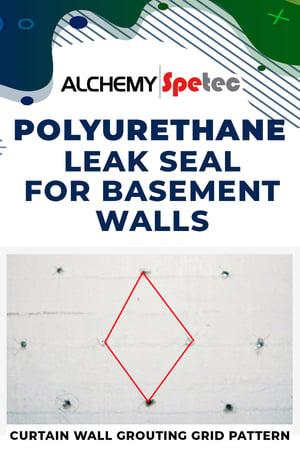
 Today’s guest blogger is John Ziebell, an independent representative of Alchemy-Spetec. Formerly the Vice President of Operations for Deneef Construction Chemicals, Inc., John has 36 years of experience in the chemical grout industry and is currently a member of the International Concrete Repair Institute (ICRI).
Today’s guest blogger is John Ziebell, an independent representative of Alchemy-Spetec. Formerly the Vice President of Operations for Deneef Construction Chemicals, Inc., John has 36 years of experience in the chemical grout industry and is currently a member of the International Concrete Repair Institute (ICRI).
Recently, I visited a homeowner in Elkhart, Texas whose basement flooded after a heavy rainstorm. The house was three years old, and this was the first time water had entered the home. When we went into the basement, I saw that a water-repellent coating was applied to the below-grade walls during initial construction, but it was unclear if a water stop had been installed at the wall joint.
To test for the leak source, I suggested installing soaker hoses in the flower beds adjacent to the basement wall, flooding the beds for several hours, and confirming if water appears at the wall or floor joints. I also recommended two different options to prevent further leaks:
Option 1 – Polyurethane Crack Injection
If the cracks in the basement walls can be clearly identified and there aren’t too many of them, the contractor should use the polyurethane crack injection procedure. First, they’ll need to remove any surface contamination with a grinder. Then, they can drill holes spaced about 1 foot apart at a 45° angle to intersect the middle of the crack or joint and flush all of the injection holes with clean water until water runs from hole to hole. Once the water flow is confirmed, they can inject the crack or joint with Spetec PUR F400 (and GEN ACC Accelerator) until it’s completely full.
Option 2 – Polyurethane Curtain Wall Grouting
If cracks in the basement walls are difficult to identify the contractor should use the polyurethane curtain wall grouting procedure. First, they’ll need to remove any surface contamination with a grinder and drill holes in a diamond grid pattern (see photo included with this post). Then, beginning at the bottom of the wall, they can inject the holes with Spetec PUR H100 (and GEN ACC Accelerator) until they reach the top of the wall.
Many people ask if grouting only around the bottom next to the leaks is effective, but this is seldom the case. Grout is injected through the entire wall because any excess grout flows down over the previous injection area, creating a lapping effect like shingles on a roof.
Both options have their advantages depending on the situation: polyurethane crack injection is a cost-effective, pinpoint approach that is ideal for a small number of clearly identifiable cracks, while curtain wall grouting is a pricier approach that is ideal for a larger number of difficult to identify cracks.


